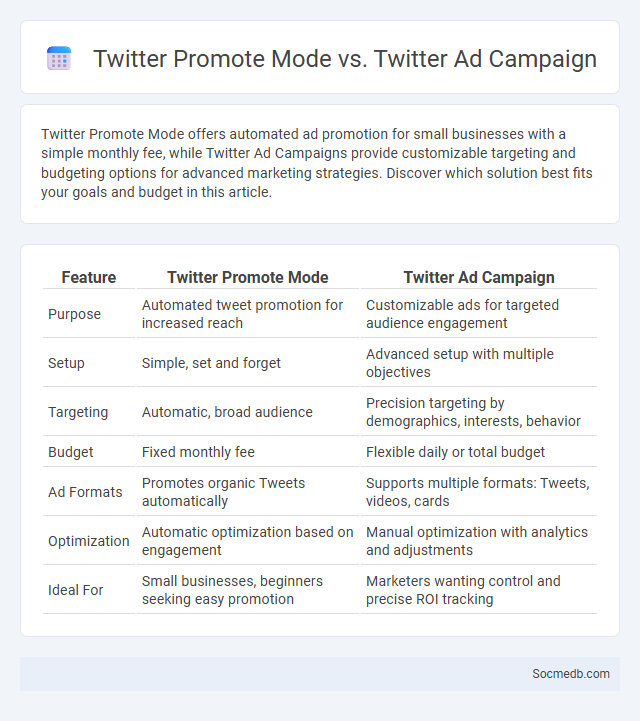
Photo illustration: Twitter Promote Mode vs Twitter Ad Campaign
Twitter Promote Mode offers automated ad promotion for small businesses with a simple monthly fee, while Twitter Ad Campaigns provide customizable targeting and budgeting options for advanced marketing strategies. Discover which solution best fits your goals and budget in this article.
Table of Comparison
| Feature | Twitter Promote Mode | Twitter Ad Campaign |
|---|---|---|
| Purpose | Automated tweet promotion for increased reach | Customizable ads for targeted audience engagement |
| Setup | Simple, set and forget | Advanced setup with multiple objectives |
| Targeting | Automatic, broad audience | Precision targeting by demographics, interests, behavior |
| Budget | Fixed monthly fee | Flexible daily or total budget |
| Ad Formats | Promotes organic Tweets automatically | Supports multiple formats: Tweets, videos, cards |
| Optimization | Automatic optimization based on engagement | Manual optimization with analytics and adjustments |
| Ideal For | Small businesses, beginners seeking easy promotion | Marketers wanting control and precise ROI tracking |
Understanding Twitter Promote Mode: An Overview
Twitter Promote Mode simplifies advertising by automatically turning tweets into promotions to boost visibility and engagement. Users pay a monthly fee to reach a targeted audience without managing individual campaigns or bids. This mode optimizes content delivery through Twitter's algorithms, making it ideal for small businesses and creators seeking consistent growth.
What is a Twitter Ad Campaign?
A Twitter Ad Campaign is a targeted marketing strategy designed to promote products, services, or content through paid advertisements on the Twitter platform. Advertisers can select specific objectives such as brand awareness, website traffic, or follower growth, leveraging Twitter's advanced targeting options including demographics, interests, and keywords. Campaigns utilize various ad formats like promoted tweets, video ads, and follower ads to engage users and maximize return on investment.
Defining General Ad Campaigns: Scope and Channels
General ad campaigns encompass a broad scope targeting diverse audiences across multiple platforms such as Facebook, Instagram, Twitter, and LinkedIn. These campaigns utilize various ad formats including display, video, and carousel ads to maximize reach and engagement. Understanding the strengths and demographics of each social media channel helps optimize your ad strategy for better performance and ROI.
Key Features of Twitter Promote Mode
Twitter Promote Mode offers automatic ad promotion of Tweets and profile to targeted audiences, enhancing visibility and engagement without manual campaign setup. It provides seamless budget control with a fixed monthly fee, allowing businesses to reach potential followers, drive website visits, and boost tweet impressions. The mode leverages Twitter's advanced targeting options, including interest, gender, location, and device demographics, maximizing campaign effectiveness for small business marketing and brand growth.
Twitter Ad Campaign Features and Customization
Twitter ad campaigns offer advanced targeting options, including demographic filters, interest categories, and keyword targeting, to reach precise audience segments. Customization features such as tailored tweet creatives, multiple ad formats like promoted tweets, video ads, and carousel ads enable marketers to deliver engaging content. Real-time analytics and A/B testing tools optimize campaign performance by tracking impressions, engagement rates, and conversion metrics.
Advantages and Limitations of Promote Mode
Promote Mode on social media streamlines advertising by automatically targeting your audience and boosting posts to increase engagement, saving time and simplifying campaign management. Its advantages include consistent ad delivery and optimized budget allocation, ideal for users seeking effortless promotion with measurable results. However, limitations arise from limited customization options and less control over targeting specifics, which may result in less precise audience reach for your unique marketing goals.
Comparing Audience Targeting Capabilities
Comparing audience targeting capabilities across social media platforms reveals distinct strengths tailored to various marketing goals. Facebook excels with its detailed demographic and interest-based targeting, allowing you to reach specific segments with precision. Instagram offers robust visual content engagement, while LinkedIn provides advanced professional and B2B targeting options ideal for business-oriented campaigns.
Budgeting and Cost Differences Explained
Social media budgeting varies significantly depending on platform choice, campaign objectives, and target audience, with costs ranging from cost-per-click (CPC) to cost-per-impression (CPM) models. Facebook and Instagram typically offer flexible budgets starting as low as $1 per day, while LinkedIn tends to have higher minimum spends due to its professional audience and CPC averaging around $5-$6. Allocating budget efficiently requires understanding these cost differences and leveraging analytics to optimize ad spend for maximum return on investment (ROI).
Performance Metrics: Measuring Success
Performance metrics such as engagement rate, click-through rate, and conversion rate are essential for measuring the success of your social media campaigns. Monitoring these key indicators provides valuable insights into audience behavior and content effectiveness, enabling data-driven decisions. Analyzing reach and follower growth further helps optimize strategies to maximize ROI and brand visibility.
Choosing the Best Option: Which Suits Your Marketing Goals?
Selecting the ideal social media platform depends on your target audience, brand voice, and marketing objectives. Platforms like Instagram excel for visual storytelling and engaging younger demographics, while LinkedIn targets professional networks ideal for B2B marketing. Assess your campaign goals, content type, and user demographics to determine the best fit for maximizing engagement and ROI.
 socmedb.com
socmedb.com